Seasonal Spatiotemporal Changes in the NDVI and Its Driving Forces in Wuliangsu Lake Basin, Northern China from 1990 to 2020
Abstract
1. Introduction
- (1)
- Describe the spatial and temporal trends of the NDVI in the Wuliangsu Lake Basin area.
- (2)
- Show the characteristics of the NDVI phenological variation and sustainability changes.
- (3)
- Identify the influence of climatic factors (seasonal precipitation and temperature) and human activities on the seasonal NDVI.
2. Materials and Methods
2.1. Study Area
2.2. Materials
2.2.1. Remote Sensing Data
2.2.2. Meteorological Data
2.2.3. Additional Data
2.3. Mathods
2.3.1. Calculation and Processing of the NDVI
2.3.2. Time Series Selection and Filtering
2.3.3. Phenology Information Extraction
2.3.4. The Trend Analysis Method
2.3.5. The Theil–Sen Median
2.3.6. Mann–Kendall Abrupt Change Detection
2.3.7. The Hurst Index
2.3.8. Residual Analysis
2.3.9. Correlation Analysis
3. Results
3.1. Analysis of NDVI Dynamic Change Characteristics
3.2. Characteristics of NDVI Phenological Variation
3.3. Spatial Distribution Characteristics of the NDVI
3.4. Spatial Distribution Characteristics of Sustainability of NDVI Changes
3.5. Correlation Analysis of the NDVI and Climate Change
3.6. Correlation Analysis of the NDVI and Human Activities
3.7. Influence of Human Activities and Climate Factors
4. Discussion
4.1. Response Relationship between NDVI Changes and Phenology
4.2. Spatial Variation of the NDVI and Seasonal Climate Response Patterns
4.3. Patterns of Anthropogenic Effects on NDVI Changes
5. Conclusions
Author Contributions
Funding
Acknowledgments
Conflicts of Interest
References
- Piao, S.; Fang, J.; Liu, H.; Zhu, B. NDVI-indicated decline in desertification in China in the past two decades. Geophys. Res. Lett. 2005, 32, 6. [Google Scholar] [CrossRef]
- Yang, X.; Zhang, K.; Jia, B.; Ci, L. Desertification assessment in China: An overview. J. Arid. Environ. 2005, 63, 517–531. [Google Scholar] [CrossRef]
- Hu, Y.; Raza, A.; Syed, N.R.; Acharki, S.; Ray, R.L.; Hussain, S.; Dehghanisanij, H.; Zubair, M.; Elbeltagi, A. Land Use/Land Cover Change Detection and NDVI Estimation in Pakistan’s Southern Punjab Province. Sustainability 2023, 15, 3572. [Google Scholar] [CrossRef]
- Ghaderpour, E.; Mazzanti, P.; Mugnozza, G.S.; Bozzano, F. Coherency and phase delay analyses between land cover and climate across Italy via the least-squares wavelet software. Int. J. Appl. Earth Obs. 2023, 118, 103241. [Google Scholar] [CrossRef]
- Al-Kindi, K.M.; Al Nadhairi, R.; Al Akhzami, S. Dynamic Change in Normalised Vegetation Index (NDVI) from 2015 to 2021 in Dhofar, Southern Oman in Response to the Climate Change. Agriculture 2023, 13, 592. [Google Scholar] [CrossRef]
- Maeda, E.E.; Pellikka, P.K.E.; Siljander, M.; Clark, B.J.F. Potential impacts of agricultural expansion and climate change on soil erosion in the Eastern Arc Mountains of Kenya. Geomorphology 2010, 123, 279–289. [Google Scholar] [CrossRef]
- Xin, Z.; Yu, X.; Lu, X. Factors controlling sediment yield in China’s Loess Plateau. Earth Surf. Process. Land. 2011, 36, 816–826. [Google Scholar] [CrossRef]
- Jagadish, S.V.; Way, D.A.; Sharkey, T.D. Scaling plant responses to high temperature from cell to ecosystem. Plant Cell Environ. 2021, 44, 1987–1991. [Google Scholar] [CrossRef] [PubMed]
- Duo, A.; Zhao, W.; Qu, X.; Jing, R.; Xiong, K. Spatio-temporal variation of vegetation coverage and its response to climate change in North China plain in the last 33 years. Int. J. Appl. Earth Obs. 2016, 53, 103–117. [Google Scholar] [CrossRef]
- Pang, G.; Wang, X.; Yang, M. Using the NDVI to identify variations in, and responses of, vegetation to climate change on the Tibetan Plateau from 1982 to 2012. Quatern. Int. 2017, 444, 87–96. [Google Scholar] [CrossRef]
- Zhou, X.; Yamaguchi, Y.; Arjasakusuma, S. Distinguishing the vegetation dynamics induced by anthropogenic factors using vegetation optical depth and AVHRR NDVI: A cross-border study on the Mongolian Plateau. Sci. Total Environ. 2018, 616–617, 730–743. [Google Scholar] [CrossRef]
- Zhang, L.; Ding, M.J.; Zhang, H.M.; Wen, C. Spatiotemporal variation of the vegetation coverage in Yangtze River basin during 1982–2015. J. Nat. Resour. 2018, 33, 2084–2097. [Google Scholar] [CrossRef]
- Garcia-Ruiz, J.M. The effects of land uses on soil erosion in Spain: A review. Catena 2010, 81, 1–11. [Google Scholar] [CrossRef]
- Mohammad, A.G.; Adam, M.A. The impact of vegetative cover type on runoff and soil erosion under different land uses. Catena 2010, 81, 97–103. [Google Scholar] [CrossRef]
- Xu, L.; Myneni, R.B.; Chapin Iii, F.S.; Callaghan, T.V.; Pinzon, J.E.; Tucker, C.J.; Zhu, Z.; Bi, J.; Ciais, P.; Tommervik, H.; et al. Temperature and vegetation seasonality diminishment over northern lands. Nat. Clim. Chang. 2013, 3, 581–586. [Google Scholar] [CrossRef]
- Piao, S.; Mohammat, A.; Fang, J.; Cai, Q.; Feng, J. NDVI-based increase in growth of temperate grasslands and its responses to climate changes in China. Glob. Environ. Chang. 2006, 16, 340–348. [Google Scholar] [CrossRef]
- Peng, S.; Chen, A.; Xu, L.; Cao, C.; Fang, J.; Myneni, R.B.; Pinzon, J.E.; Tucker, C.J.; Piao, S. Recent change of vegetation growth trend in China. Environ. Res. Lett. 2011, 6, 044027. [Google Scholar] [CrossRef]
- Jin, K.; Wang, F.; Han, J.Q.; Shi, S.; Ding, W. Contribution of climatic change and human activities to vegetation NDVI change over China during 1982–2015. Acta Geogr. Sin. 2020, 75, 961–974. [Google Scholar] [CrossRef]
- Shen, Q.; Cong, Z.; Lei, H. Evaluating the impact of climate and underlying surface change on runoff within the Budyko framework: A study across 224 catchments in China. J. Hydrol. 2017, 554, 251–262. [Google Scholar] [CrossRef]
- Hu, K.H.; Zhang, Z.; Gao, M.; Lu, Y. Variations in vegetation cover and natural factors of provinces in China along Silk Road Economic Belt during 2000–2018. Trans. CSAE 2020, 36, 149–157. [Google Scholar] [CrossRef]
- Liu, X.F.; Zhu, X.F.; Pan, Y.Z.; Li, Y.Z.; Zhao, A.Z. Spatiotemporal changes in vegetation coverage in China during 1982–2012. Acta Ecol. Sin. 2015, 35, 5331–5342. [Google Scholar] [CrossRef]
- Liu, J.Y.; Ning, J.; Kuang, W.; Xu, X.; Zhang, S.; Yan, C.Z.; Li, R.; Wu, S.; Hu, Y.; Du, G.; et al. Spatio-temporal patterns and characteristics of land-use change in China during 2010–2015. Acta Geogr. Sin. 2018, 73, 789–802. [Google Scholar] [CrossRef]
- You, N.H.; Dong, J.W.; Xiao, T.; Liu, J.; Xiao, X. The effects of the “Grain for Green” project on gross primary productivity in the Loess Plateau. Sci. Geogr. Sin. 2020, 40, 315–323. [Google Scholar] [CrossRef]
- Fan, J.Z.; Li, D.K.; Dong, J.F. Remote sensing analysis of vegetation restoration in key ecological construction areas of Shaanxi province. Trans. CSAE 2012, 28, 228–234. [Google Scholar]
- Zhao, A.Z.; Pei, T.; Cao, S.; Zhang, A.; Fan, Q.; Wang, J. Impacts of urbanization on vegetation growth and surface urban heat island intensity in the Beijing-Tianjin-Hebei. China Environ. Sci. 2020, 40, 1825–1833. Available online: http://www.zghjkx.com.cn/EN/Y2020/V40/I4/1825 (accessed on 10 May 2022).
- Bardgett, R.D.; Bullock, J.M.; Lavorel, S.; Manning, P.; Schaffner, U.; Ostle, N.; Chomel, M.; Durigan, G.; Fry, E.L.; Johnson, D.; et al. Combatting global grassland degradation. Nat. Rev. Earth Environ. 2021, 2, 720–735. [Google Scholar] [CrossRef]
- Chen, X.; Yu, L.; Du, Z.; Xu, Y.; Zhao, J.; Zhao, H.; Zhang, G.; Peng, D.; Gong, P. Distribution of ecological restoration projects associated with land use and land cover change in China and their ecological impacts. Sci Total Environ. 2022, 825, 153938. [Google Scholar] [CrossRef]
- Jia, X.; Jin, Z.; Mei, X.; Wang, D.; Zhu, R.; Zhang, X.; Huang, Z.; Li, C.; Zhang, X. Monitoring and Effect Evaluation of an Ecological Restoration Project Using Multi-Source Remote Sensing: A Case Study of Wuliangsuhai Watershed in China. Land 2023, 12, 349. [Google Scholar] [CrossRef]
- Albarakat, R.; Lakshmi, V. Comparison of Normalized Difference Vegetation Index Derived from Landsat, MODIS, and AVHRR for the Mesopotamian Marshes Between 2002 and 2018. Remote Sens. 2019, 11, 1245. [Google Scholar] [CrossRef]
- Loukas, A.; Vasiliades, L.; Tzabiras, J. Climate change effects on drought severity. Adv. Geosci. 2008, 17, 23–29. [Google Scholar] [CrossRef]
- Mehr, A.D.; Sorman, A.U.; Kahya, E. Climate change impacts on meteorological drought using SPI and SPEI: Case study of Ankara, Turkey. Hydrol. Sci. J. 2020, 65, 254–268. [Google Scholar] [CrossRef]
- Meresa, H.K.; Osuch, M.; Romanowicz, R. Hydro-meteorological drought projections into the 21-st century for selected Polish catchments. Water 2016, 8, 206. [Google Scholar] [CrossRef]
- Aksoy, H.; Cetin, M.; Eris, E.; Burgan, H.I.; Cavus, Y.; Yildirim, I.; Sivapalan, M. Critical drought intensity-duration-frequency curves based on total probability theorem-coupled frequency analysis. Hydrol. Sci. J. 2021, 66, 1337–1358. [Google Scholar] [CrossRef]
- Bannari, A.; Morin, D.; Bonn, F.; Huete, A. A review of vegetation indices. Remote Sens. Rev. 1995, 13, 95–120. [Google Scholar] [CrossRef]
- Houborg, R.; Soegaard, H.; Boegh, E. Combining vegetation index and model inversion methods for the extraction of key vegetation biophysical parameters using Terra and Aqua MODIS reflectance data. Remote Sens. Environ. 2007, 106, 39–58. [Google Scholar] [CrossRef]
- Huete, A.; Didan, K.; van Leeuwen, W.; Miura, T.; Glenn, E. MODIS vegetation indices. Land. Remote Sens. Glob. Environ. Chang. 2011, 11, 579–602. [Google Scholar]
- Pettorelli, N.; Vik, J.O.; Mysterud, A.; Gaillard, J.-M.; Tucker, C.J.; Stenseth, N.C. Using the satellite-derived NDVI to assess ecological responses to environmental change. Trends Ecol. Evol. 2005, 20, 503–510. [Google Scholar] [CrossRef]
- Zhao, H.; Gu, B.; Lindley, S.; Zhu, T.; Fan, J. Regulation factors driving vegetation changes in China during the past 20 years. J. Geogr. Sci. 2023, 33, 508–528. [Google Scholar] [CrossRef]
- Li, B.; Tao, S.; Dawson, R.W. Relations between AVHRR NDVI and eco-climatic parameters in China. Int. J. Remote Sens. 2002, 23, 989–999. [Google Scholar] [CrossRef]
- Wu, T.; Feng, F.; Lin, Q.; Bai, H. A spatio-temporal prediction of NDVI based on precipitation: An application for grazing management in the arid and semi-arid grasslands. Int. J. Remote Sens. 2020, 41, 2359–2373. [Google Scholar] [CrossRef]
- Chen, L.; Wei, W.; Fu, B.; Lü, Y. Soil and water conservation on the Loess Plateau in China: Review and perspective. Prog. Phys. Geogr. 2007, 31, 389–403. [Google Scholar] [CrossRef]
- Zhang, Y.; Ye, A. Spatial and temporal variations in vegetation coverage observed using AVHRR GIMMS and Terra MODIS data in the mainland of China. Int. J. Remote Sens. 2020, 41, 4238–4268. [Google Scholar] [CrossRef]
- Liu, J.Y.; Xu, X.L.; Shao, Q.Q. The spatial and temporal characteristics of grassland degradation in the Three-River Headwaters region in Qinghai Province. Acta Geogr. Sin. 2008, 63, 364–376. [Google Scholar] [CrossRef]
- Aneseyee, A.B.; Elias, E.; Soromessa, T.; Feyisa, G.L. Land use/land cover change effect on soil erosion and sediment delivery in the Winike watershed, Omo Gibe Basin, Ethiopia. Sci. Total Environ. 2020, 728, 138776. [Google Scholar] [CrossRef] [PubMed]
- Wang, Z.L.; Huang, Z.Q.; Li, J.; Ruida, Z.; Huang, W. Assessing impacts of meteorological drought on vegetation at catchment scale in China based on SPEI and NDVI. Trans. CSAE 2016, 32, 177–186. [Google Scholar] [CrossRef]
- Qin, D.H. Climate change science and sustainable development. Prog. Geogr. 2014, 33, 874–883. [Google Scholar] [CrossRef]
- Jiao, K.W.; Gao, J.B.; Wu, S.H.; Hou, W. Research progress on the response processes of vegetation activity to climate change. Acta Ecol. Sin. 2018, 38, 2229–2238. [Google Scholar] [CrossRef]
- Hutchinson, M.F. Interpolation of Rainfall Data with Thin Plate Smoothing Splines—Part I: Two-Dimensional Smoothing of Data with Short Range Correlation. J. Geogr. Inf. Decis. Anal. 1998, 2, 139–151. [Google Scholar]
- Savitzky, A.; Golay, M.J.E. Smoothing and differentiation of data by simplified least squares procedures. Anal. Chem. 1964, 36, 1627–1639. [Google Scholar] [CrossRef]
- Hurst, H.E. Long-term storage capacity of reservoirs. Trans. Am. Soc. Civ. Eng. 1951, 116, 770–799. [Google Scholar] [CrossRef]
- Mandelbrot, B.B.; Wallis, J.R. Robustness of the rescaled range R/S in the measurement of noncyclic long run statistical dependence. Water Resour. Res. 1969, 5, 967–988. [Google Scholar] [CrossRef]
- Jayaweera, G.R.; Mikkelsen, D.S. Assessment of ammonia volatilization from flooded soil systems. Adv. Agron. 1991, 45, 303–356. [Google Scholar] [CrossRef]
- Evans, J.; Geerken, R. Discrimination between climate and human-induced dryland degradation. J. Arid. Environ. 2004, 57, 535–554. [Google Scholar] [CrossRef]
- Stow, D.A.; Hope, A.; McGuire, D.; Verbyla, D.; Gamon, J.; Huemmrich, F.; Houston, S.; Racine, C.; Sturm, M.; Tape, K.; et al. Remote sensing of vegetation and land-cover change in Arctic Tundra ecosystems. Remote Sens. Environ. 2004, 89, 281–308. [Google Scholar] [CrossRef]
- Jochner, S.; Menzel, A. Does flower phenology mirror the slowdown of global warming? Ecol. Evol. 2015, 5, 2284–2295. [Google Scholar] [CrossRef] [PubMed]
- Li, Z.; Zhou, T.; Zhao, X.; Huang, K.; Gao, S.; Wu, H.; Luo, H. Assessments of Drought Impacts on Vegetation in China with the Optimal Time Scales of the Climatic Drought Index. Int. J. Environ. Res. Public Health 2015, 12, 7615–7634. [Google Scholar] [CrossRef]
- Vitasse, Y.; Delzon, S.; Dufrêne, E.; Pontailler, J.Y.; Louvet, J.M.; Kremer, A.; Michalet, R. Leaf phenology sensitivity to temperature in European trees: Do within-species populations exhibit similar responses? Agric. For. Meteorol. 2009, 149, 735–744. [Google Scholar] [CrossRef]
- Miller-Rushing, A.J.; Primack, R.B. Global warming and flowering times in Thoreau’s Concord: A community perspective. Ecology 2008, 89, 332–341. [Google Scholar] [CrossRef]
- Estrella, N.; Menzel, A. Responses of leaf colouring in four deciduous tree species to climate and weather in Germany. Clim. Res. 2006, 32, 253–267. [Google Scholar] [CrossRef]
- Delpierre, N.; Dufrêne, E.; Soudani, K.; Ulrich, E.; Cecchini, S.; Boé, J.; François, C. Modelling interannual and spatial variability of leaf senescence for three deciduous tree species in France. Agric. For. Meteorol. 2009, 149, 938–948. [Google Scholar] [CrossRef]
- Zeng, H.; Jia, G.; Epstein, H. Recent changes in phenology over the northern high latitudes detected from multi-satellite data. Environ. Res. Lett. 2011, 6, 045508. [Google Scholar] [CrossRef]
- Feng, X.; Fu, B.; Piao, S.; Wang, S.; Ciais, P.; Zeng, Z.; Lü, Y.; Zeng, Y.; Li, Y.; Jiang, X. Revegetation in China’s Loess Plateau is approaching sustainable water resource limits. Nat. Clim. Chang. 2016, 6, 1019–1022. [Google Scholar] [CrossRef]
- Sun, W.; Song, X.; Mu, X.; Gao, P.; Wang, F.; Zhao, G. Spatiotemporal vegetation cover variations associated with climate change and ecological restoration in the Loess Plateau. Agric. For. Meteorol. 2015, 209, 87–99. [Google Scholar] [CrossRef]
- Huang, T.; Wu, Z.; Xiao, P.; Sun, Z.; Liu, Y.; Wang, J.; Wang, Z. Possible Future Climate Change Impacts on the Meteorological and Hydrological Drought Characteristics in the Jinghe River Basin, China. Remote Sens. 2023, 15, 1297. [Google Scholar] [CrossRef]
- Fu, B.J.; Meng, Q.H.; Qiu, Y.; Zhao, W.W.; Zhang, Q.J.; Davidson, D.A. Effects of land use on soil erosion and nitrogen loss in the hilly area of the Loess Plateau, China. Land. Degrad. Dev. 2004, 15, 87–96. [Google Scholar] [CrossRef]
- Yu, L.; Wu, Z.T.; Du, Z.Q.; Zhang, H.; Liu, Y. Quantitative analysis of the effects of human activities on vegetation in the Beijing-Tianjin sandstorm source region under the climate change. Chin. J. Appl. Ecol. 2020, 31, 2007–2014. [Google Scholar] [CrossRef]
- Lü, Y.; Zhang, L.; Feng, X.; Zeng, Y.; Fu, B.; Yao, X.; Li, J.; Wu, B. Recent ecological transitions in China: Greening, browning and influential factors. Sci. Rep. 2015, 5, 8732. [Google Scholar] [CrossRef] [PubMed]
- Descals, A.; Verger, A.; Yin, G.F.; Peñuelas, J. A threshold method for robust and fast estimation of land-surface phenology using Google Earth Engine. IEEE J.-Stars 2021, 14, 601–606. [Google Scholar] [CrossRef]

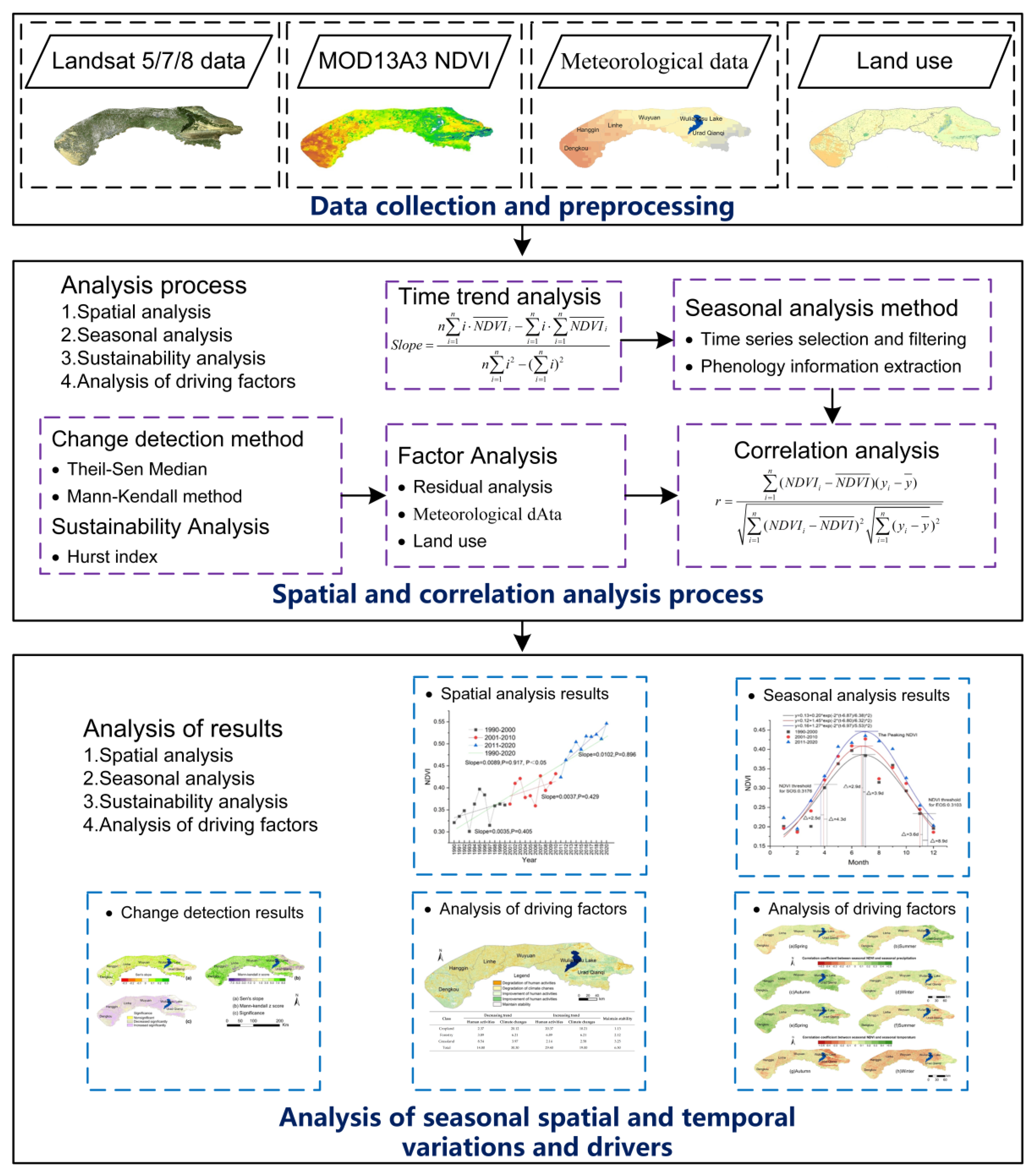
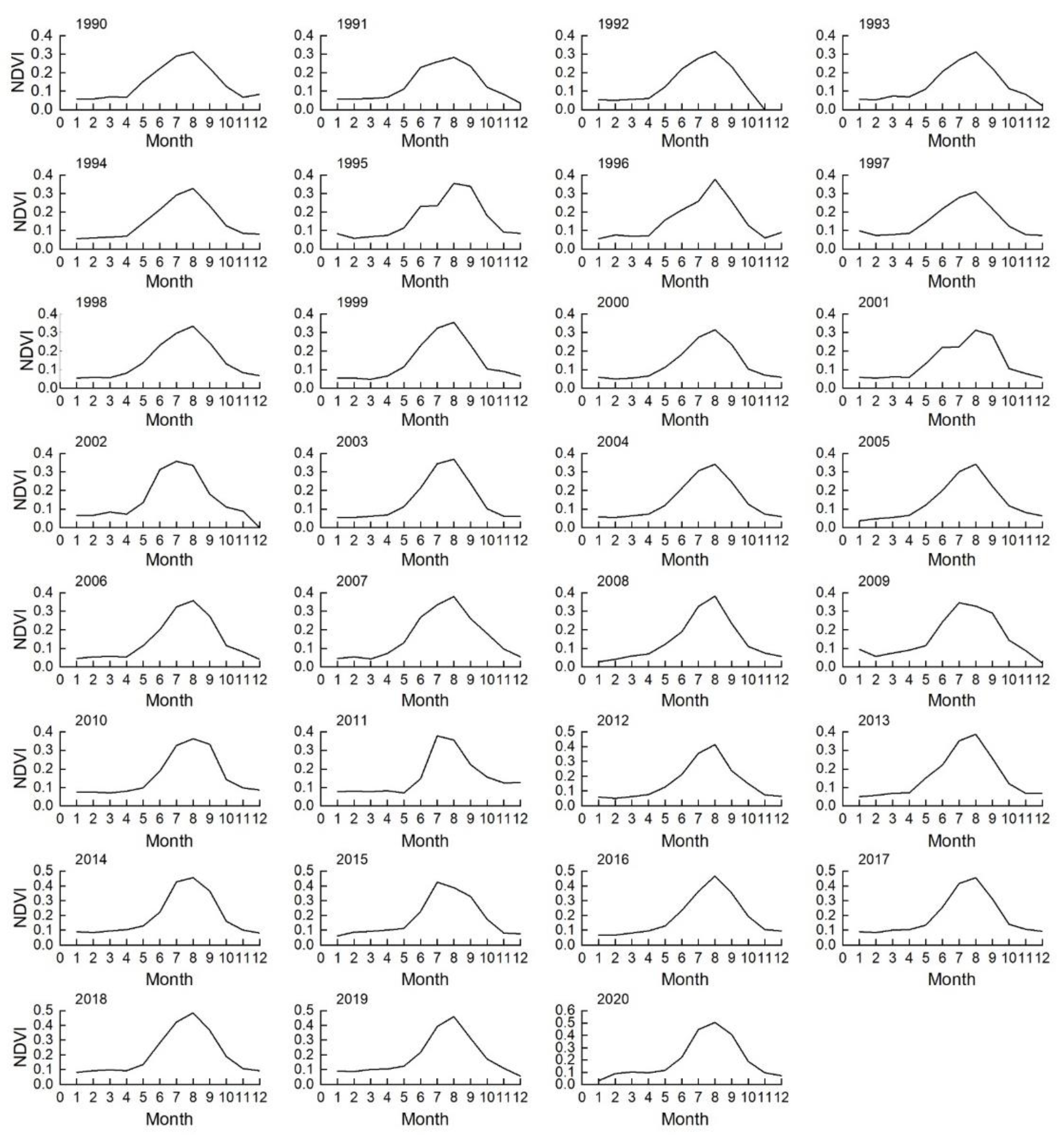
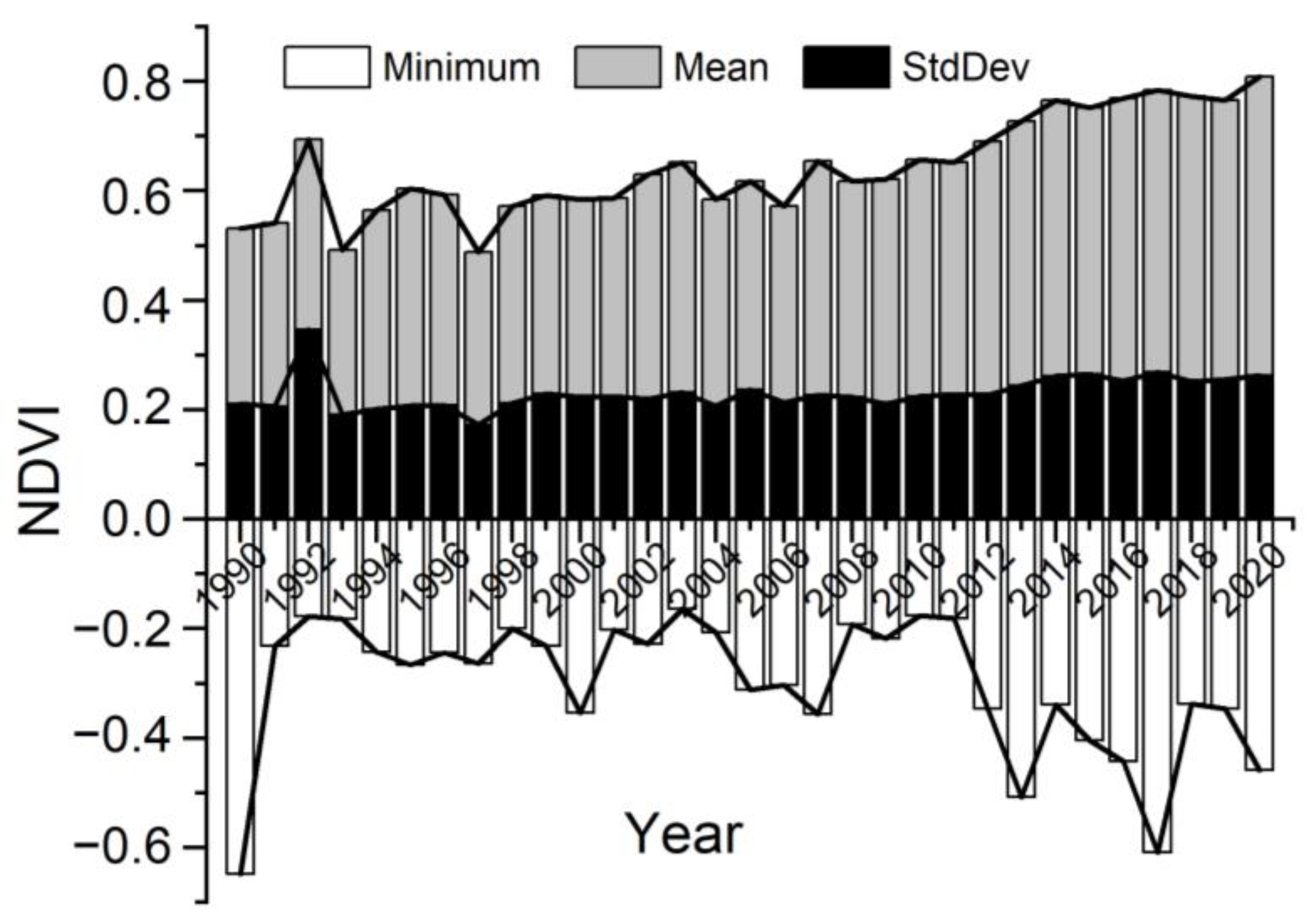

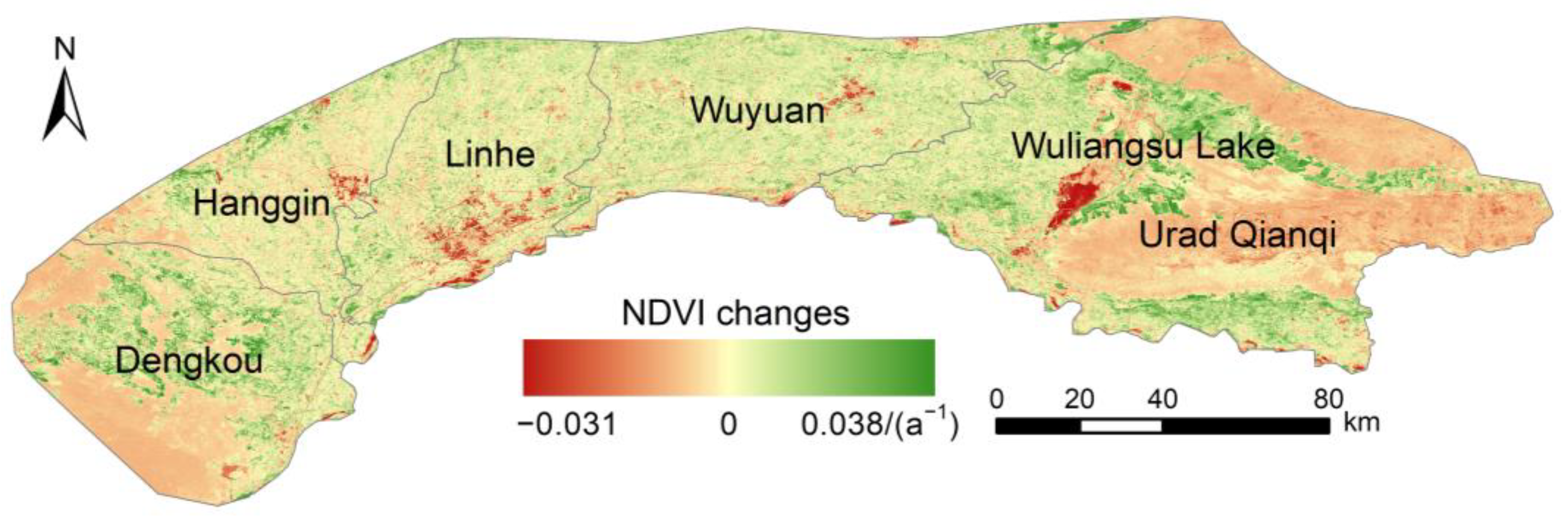
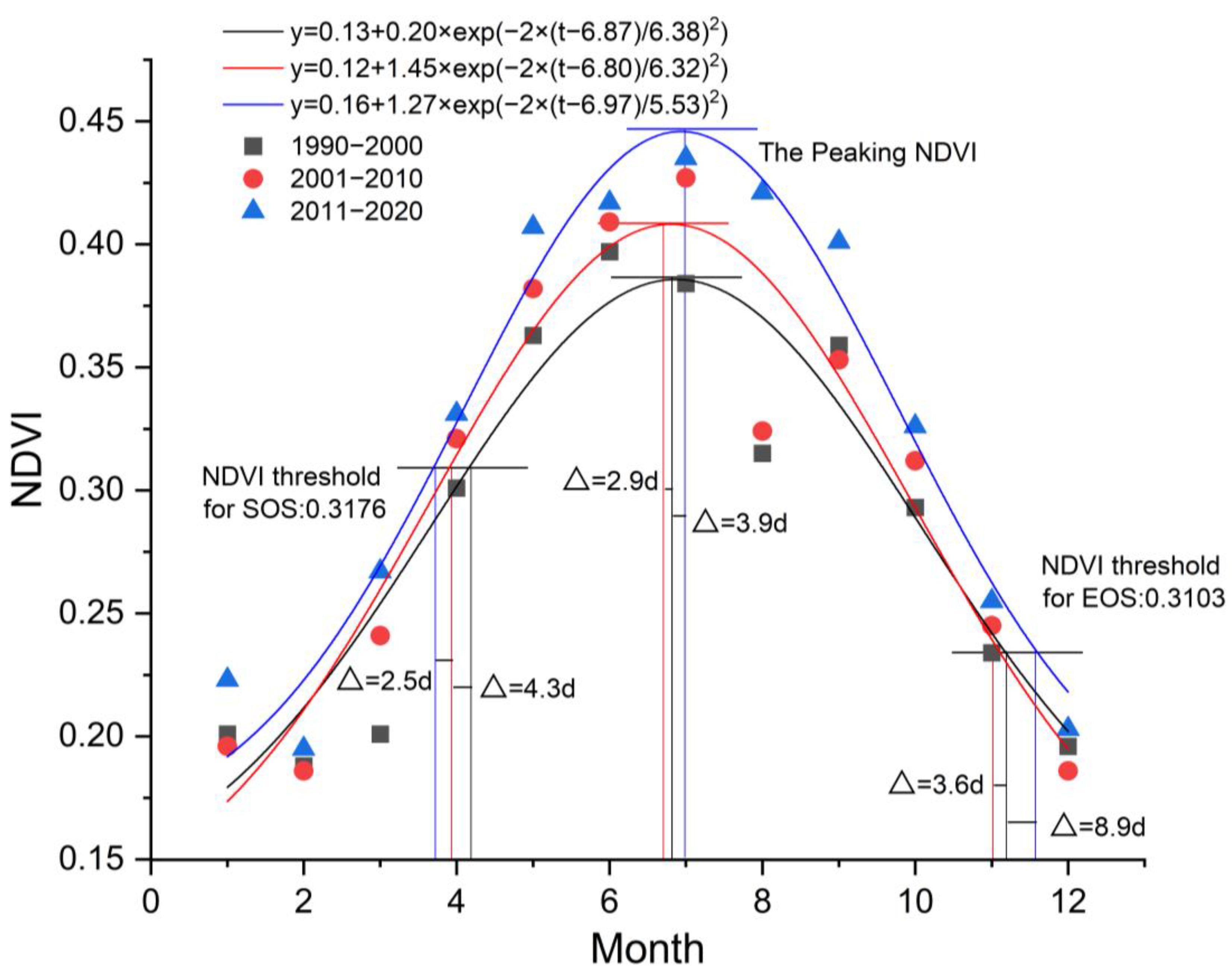
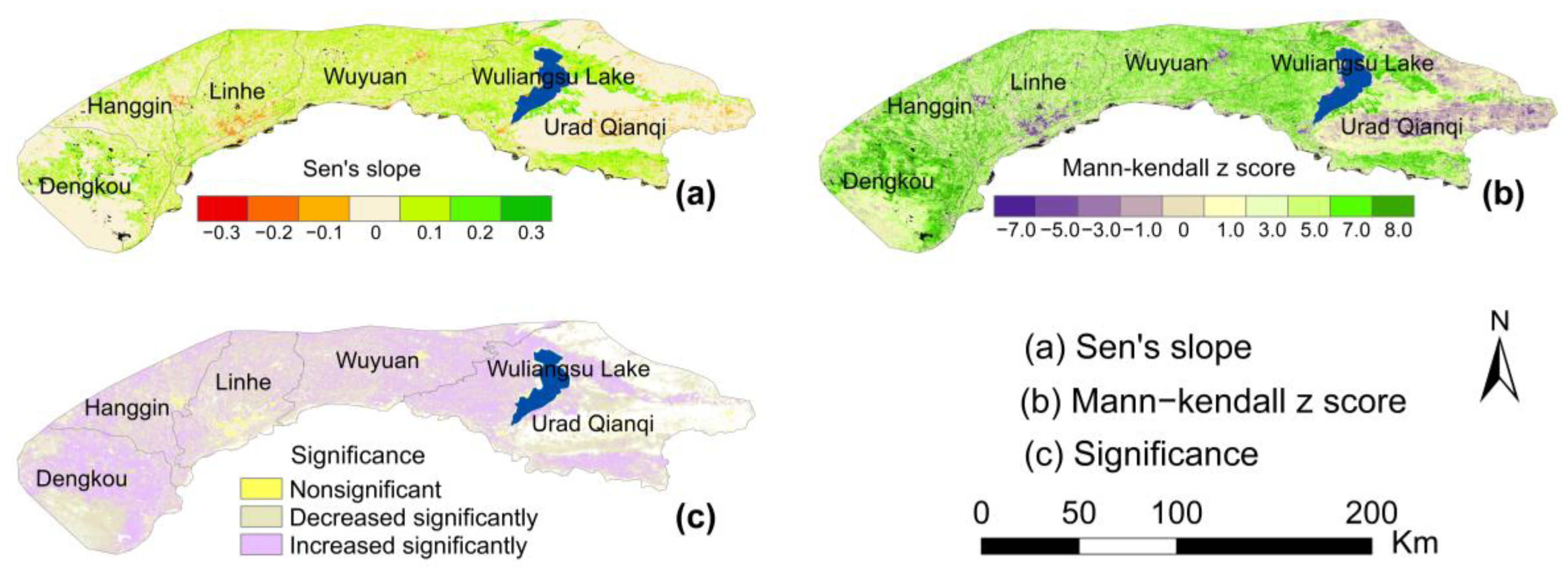
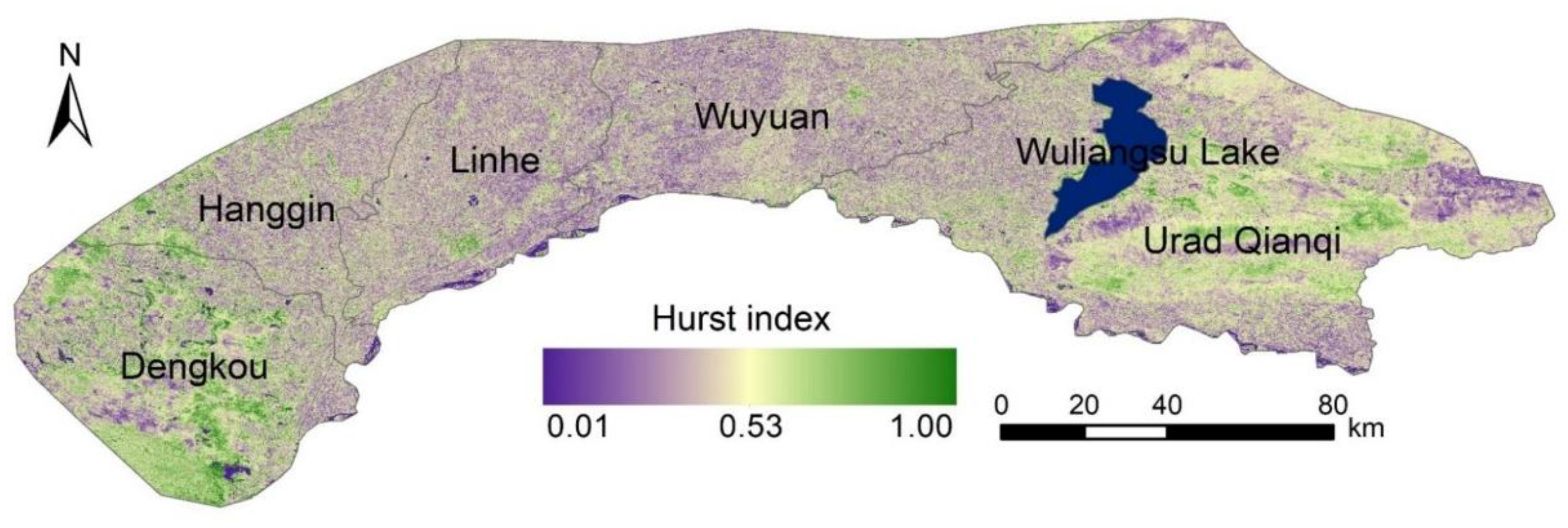
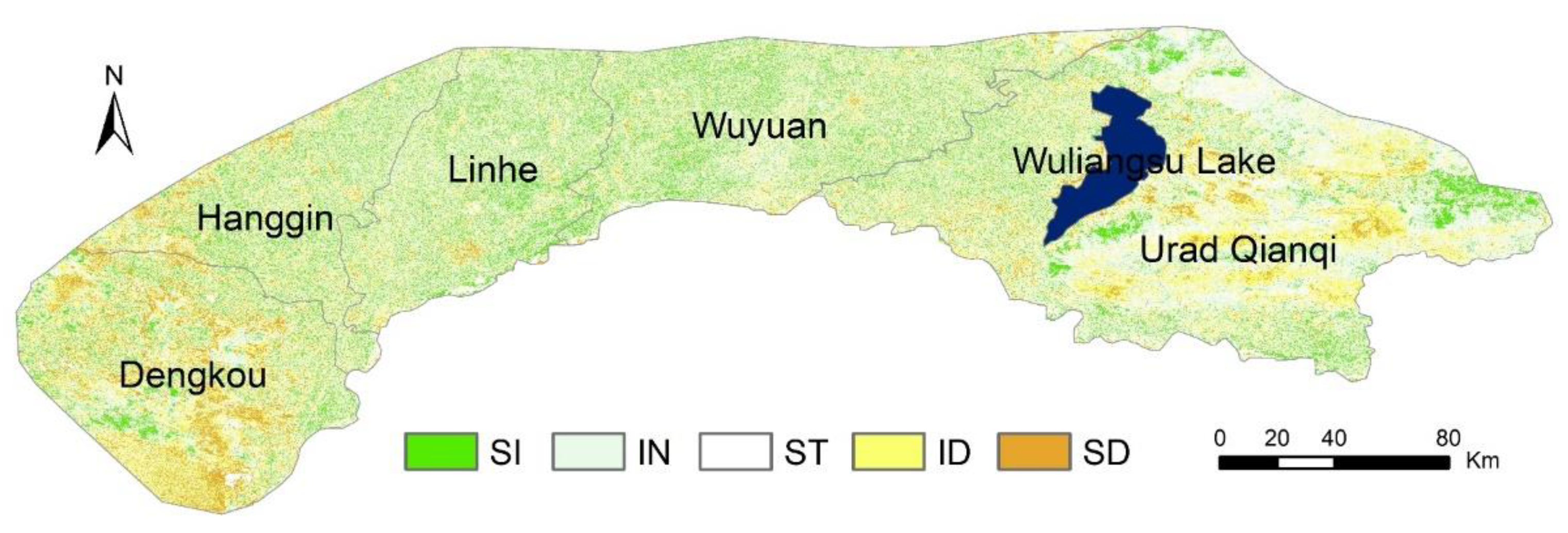
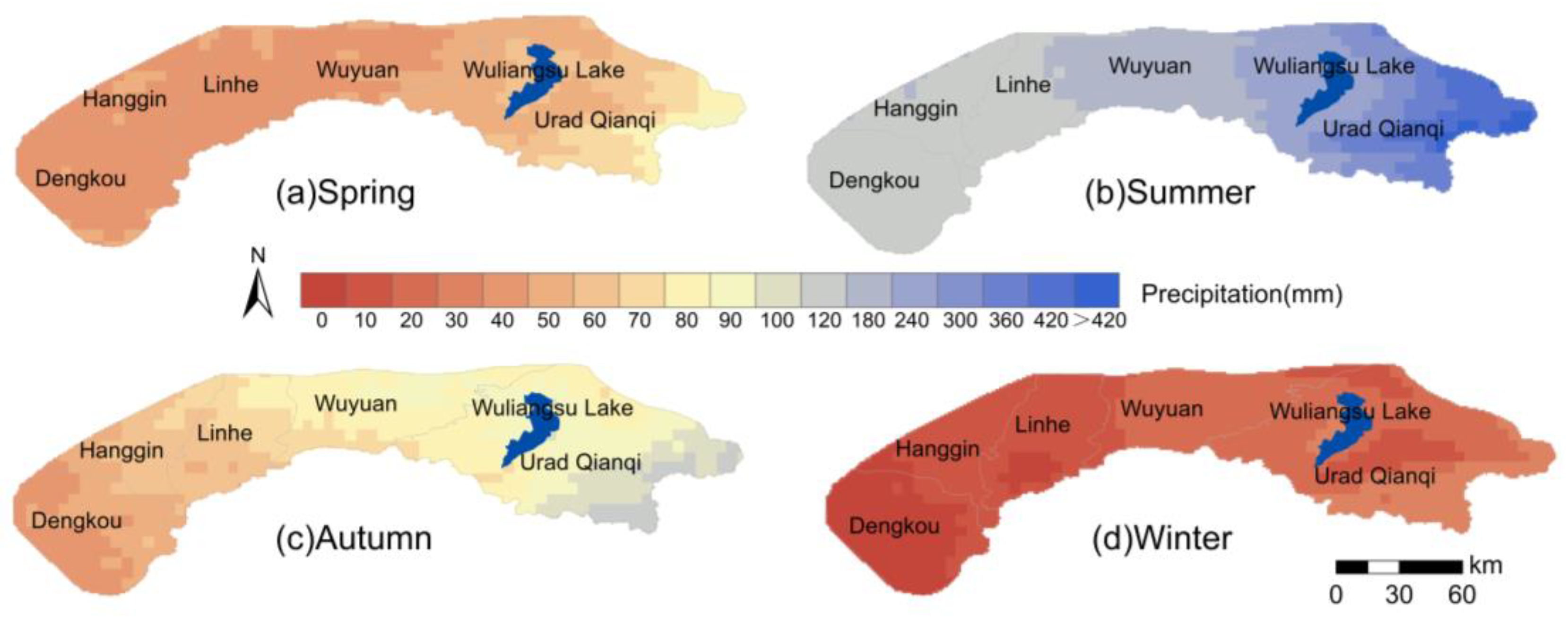

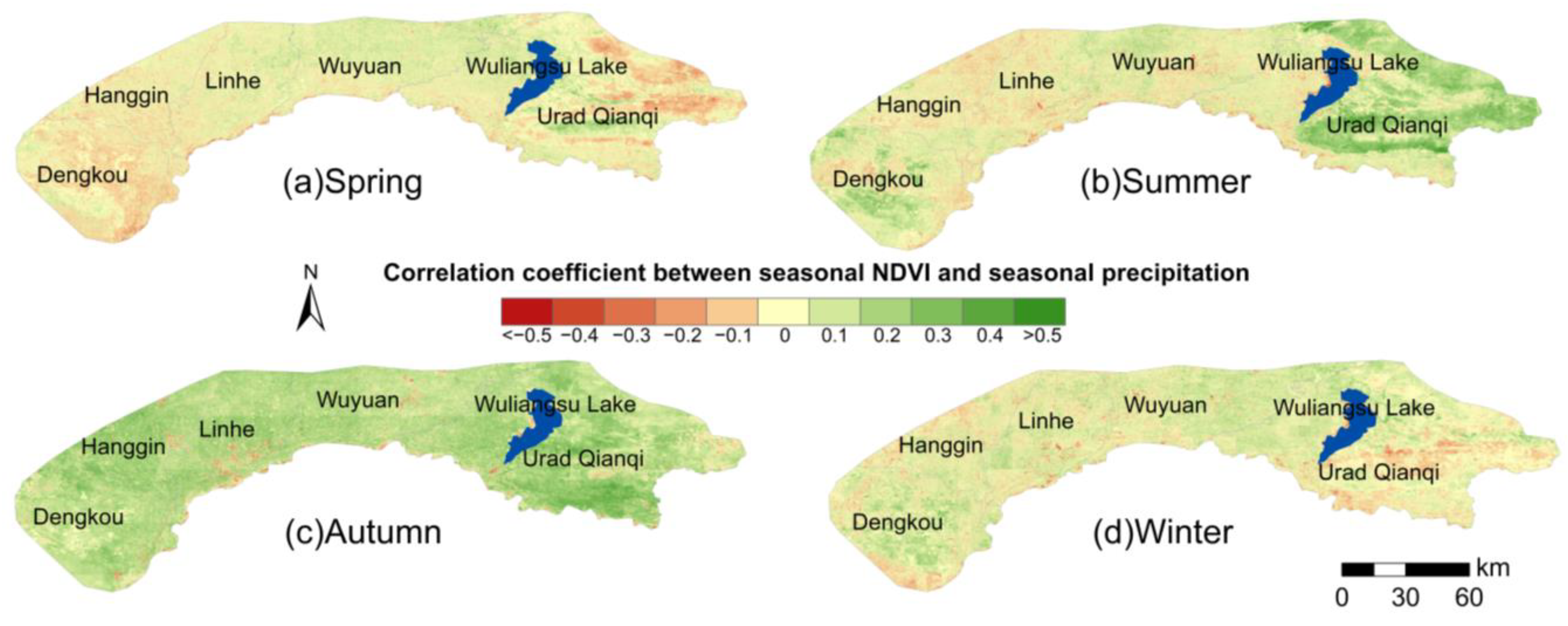
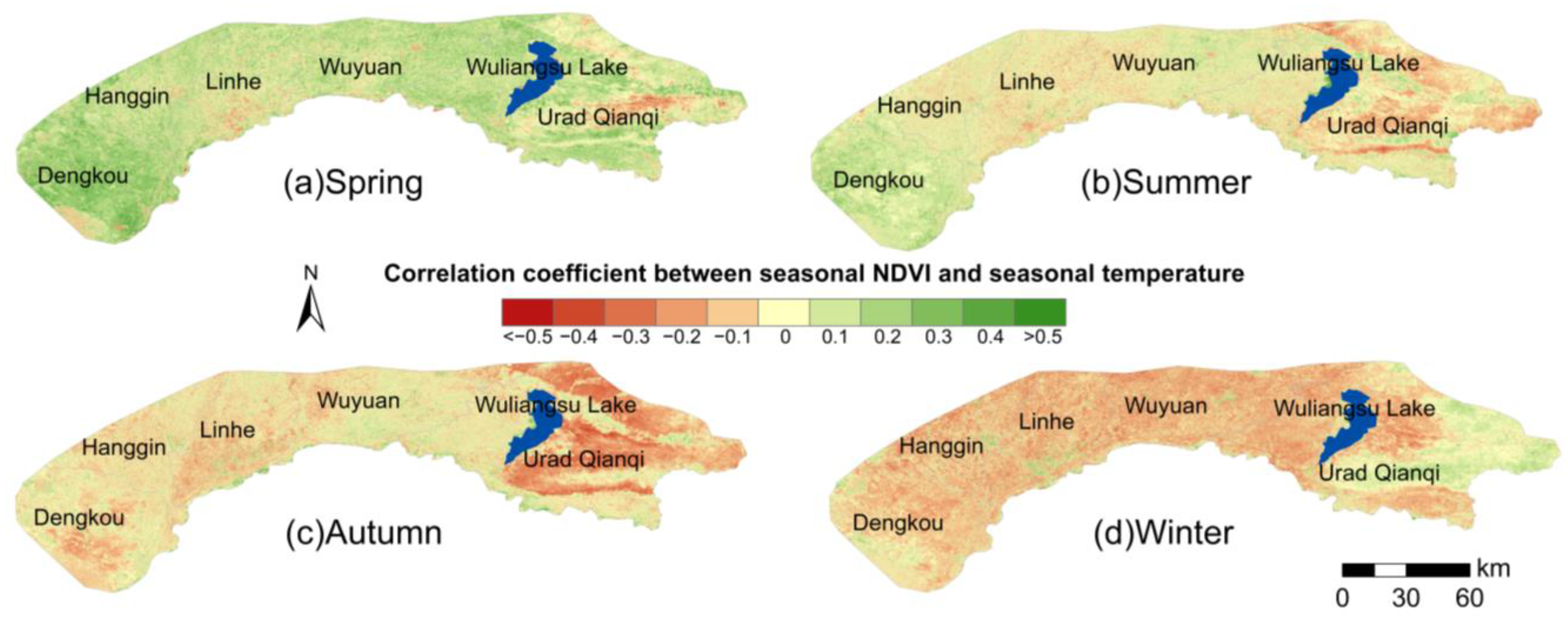
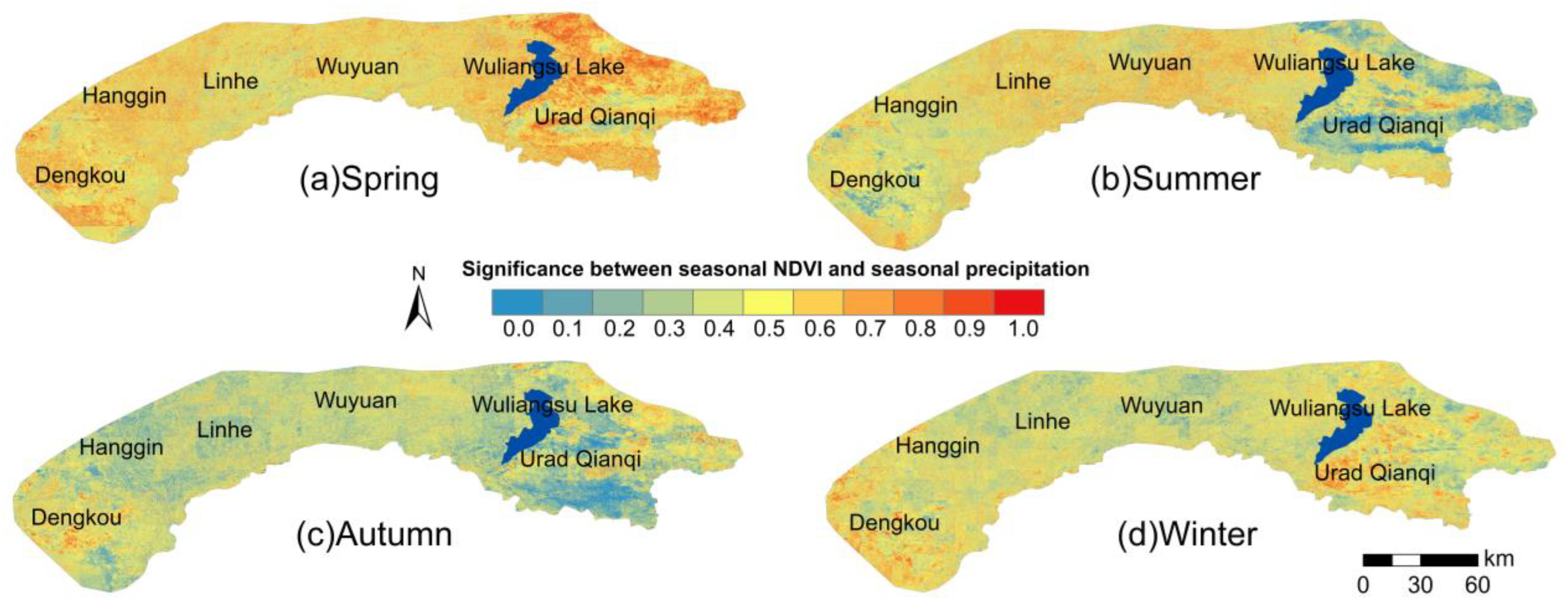



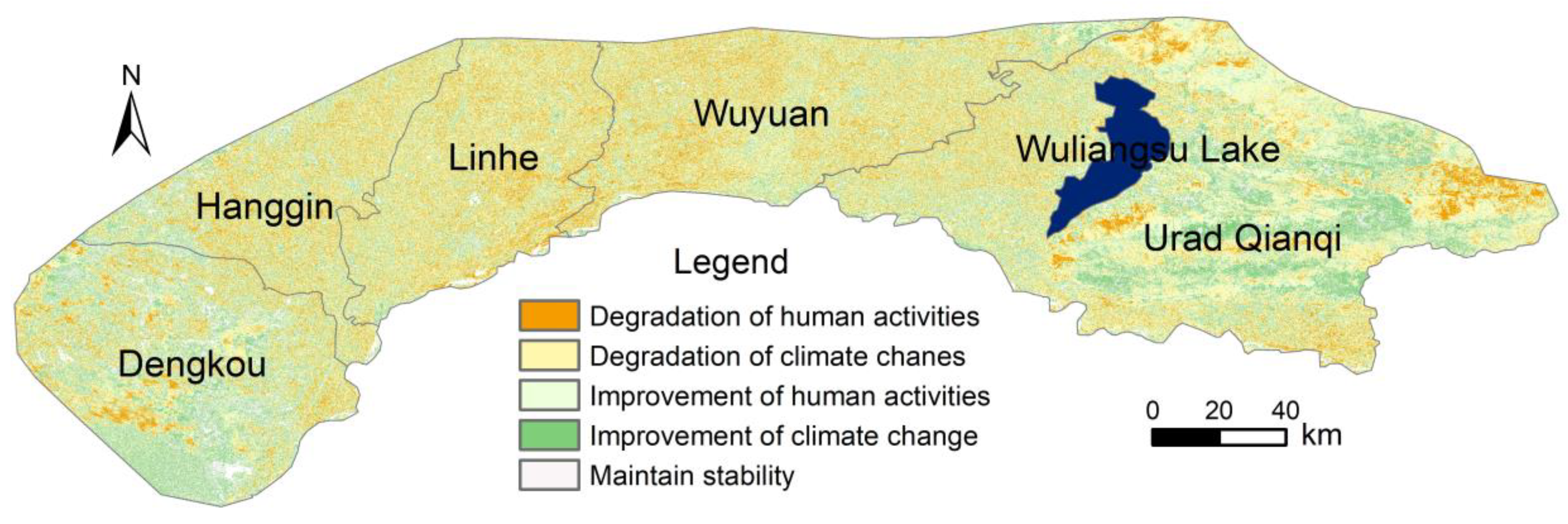
| Sensors | Spatial Resolutions | Years | Number | Missing Data | Data Sources |
|---|---|---|---|---|---|
| Landsat 5 TM | 16 days, 30 m | 1990–2012 | 2550 | Decmber 2005 November 2007 December 2007 January 2008 December 2008 November 2012 December 2012 | https://earthengine.google.com/, accessed on 18 May 2022 |
| Landsat 7 ETM+ | 16 days, 30 m | 2013 | 224 | No | https://earthengine.google.com/, accessed on 18 May 2022 |
| Landsat 8 OLI | 16 days, 30 m | 2014–2020 | 1023 | No |
| Slope | Z | Hurst Index | Change Types |
|---|---|---|---|
| ≥0.0001 | ≥1.96 | >0.5 | Significant improvement (SI) |
| ≥0.0001 | −1.96~1.96 | >0.5 | Insignificant improvement (IN) |
| −0.0001 | - | <0.5 | Stable (ST) |
| −0.0001~0.0001 | −1.96~1.96 | >0.5 | Insignificant degradation (ID) |
| <−0.0001 | ≤−1.96 | >0.5 | Significant degradation (SD) |
| Slope | Z | Hurst Index | Change Types | Proportion of Area (%) |
|---|---|---|---|---|
| ≥0.0001 | ≥1.96 | >0.5 | Significant improvement (SI) | 49.10 |
| ≥0.0001 | −1.96~1.96 | >0.5 | Insignificant improvement (IN) | 6.02 |
| −0.0001 | - | <0.5 | Stable (ST) | 40.25 |
| −0.0001~0.0001 | −1.96~1.96 | >0.5 | Insignificant degradation (ID) | 1.20 |
| <−0.0001 | ≤−1.96 | >0.5 | Significant degradation (SD) | 3.45 |
| Class | Decreasing Trend | Increasing Trend | Maintain Stability | ||
|---|---|---|---|---|---|
| Human Activities | Climate Changes | Human Activities | Climate Changes | ||
| Cropland | 2.37 | 20.12 | 20.37 | 10.21 | 1.13 |
| Forestry | 3.89 | 6.21 | 6.89 | 6.21 | 2.12 |
| Grassland | 8.54 | 3.97 | 2.14 | 2.58 | 3.25 |
| Total | 14.80 | 30.30 | 29.40 | 19.00 | 6.50 |
Disclaimer/Publisher’s Note: The statements, opinions and data contained in all publications are solely those of the individual author(s) and contributor(s) and not of MDPI and/or the editor(s). MDPI and/or the editor(s) disclaim responsibility for any injury to people or property resulting from any ideas, methods, instructions or products referred to in the content. |
© 2023 by the authors. Licensee MDPI, Basel, Switzerland. This article is an open access article distributed under the terms and conditions of the Creative Commons Attribution (CC BY) license (https://creativecommons.org/licenses/by/4.0/).
Share and Cite
Li, C.; Jia, X.; Zhu, R.; Mei, X.; Wang, D.; Zhang, X. Seasonal Spatiotemporal Changes in the NDVI and Its Driving Forces in Wuliangsu Lake Basin, Northern China from 1990 to 2020. Remote Sens. 2023, 15, 2965. https://doi.org/10.3390/rs15122965
Li C, Jia X, Zhu R, Mei X, Wang D, Zhang X. Seasonal Spatiotemporal Changes in the NDVI and Its Driving Forces in Wuliangsu Lake Basin, Northern China from 1990 to 2020. Remote Sensing. 2023; 15(12):2965. https://doi.org/10.3390/rs15122965
Chicago/Turabian StyleLi, Caixia, Xiang Jia, Ruoning Zhu, Xiaoli Mei, Dong Wang, and Xiaoli Zhang. 2023. "Seasonal Spatiotemporal Changes in the NDVI and Its Driving Forces in Wuliangsu Lake Basin, Northern China from 1990 to 2020" Remote Sensing 15, no. 12: 2965. https://doi.org/10.3390/rs15122965
APA StyleLi, C., Jia, X., Zhu, R., Mei, X., Wang, D., & Zhang, X. (2023). Seasonal Spatiotemporal Changes in the NDVI and Its Driving Forces in Wuliangsu Lake Basin, Northern China from 1990 to 2020. Remote Sensing, 15(12), 2965. https://doi.org/10.3390/rs15122965






